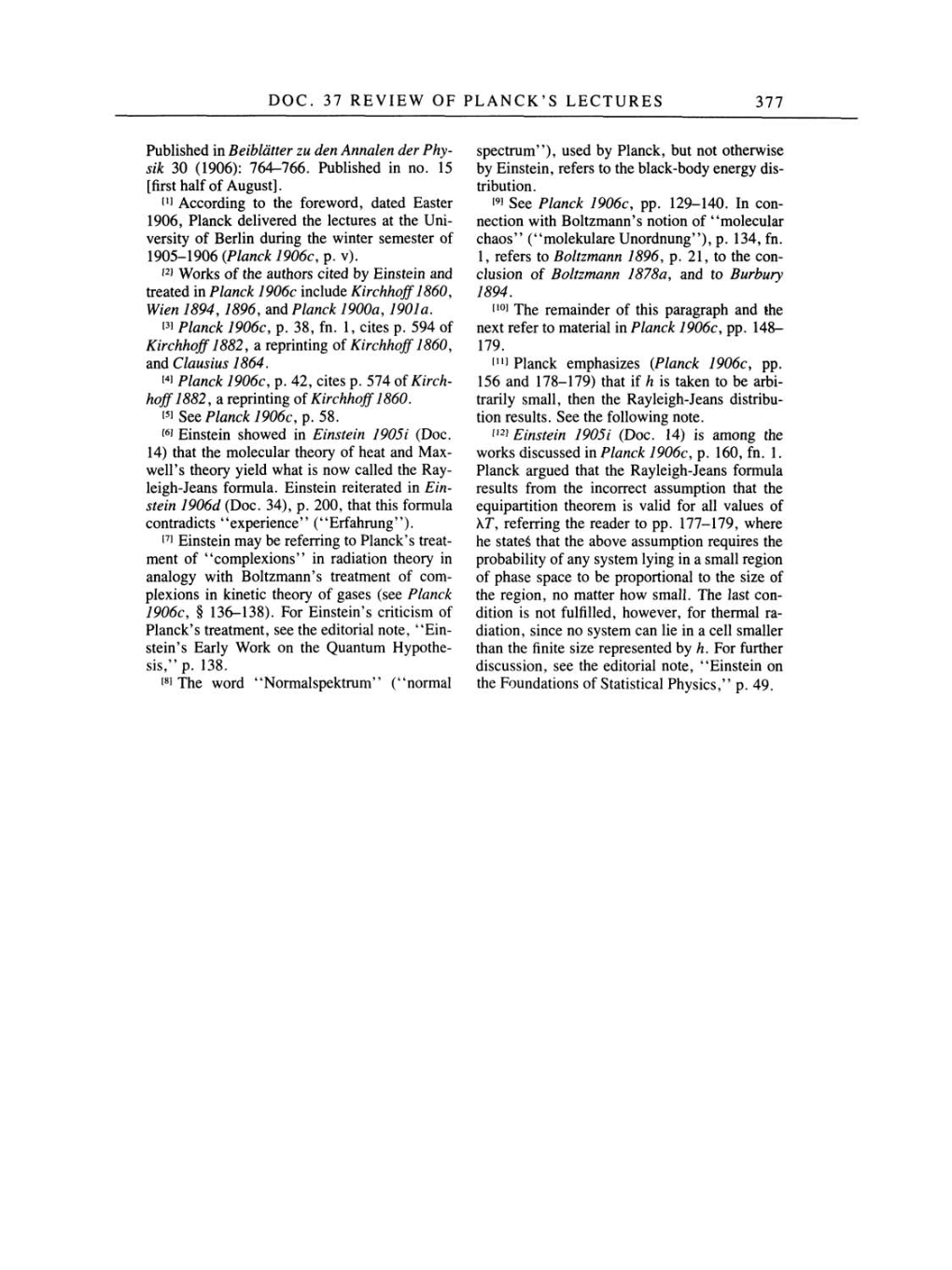DOC.
37
REVIEW
OF
PLANCK'S LECTURES
377
Published in Beiblätter
zu
den Annalen
der
Phy-
sik 30
(1906):
764-766.
Published in
no. 15
[first
half
of
August].
[1] According
to the
foreword,
dated Easter
1906,
Planck delivered the lectures at
the
Uni-
versity
of
Berlin
during
the winter semester of
1905-1906
(Planck
1906c,
p.
v).
[2]
Works
of
the authors cited
by
Einstein and
treated in
Planck
1906c include Kirchhoff
1860,
Wien
1894, 1896,
and
Planck
1900a, 1901a.
[3]
Planck
1906c,
p.
38,
fn.
1,
cites
p.
594
of
Kirchhoff 1882,
a reprinting
of
Kirchhoff
1860,
and
Clausius
1864.
[4]
Planck
1906c,
p.
42,
cites
p.
574
of Kirch-
hoff 1882,
a reprinting
of
Kirchhoff
1860.
[5]
See
Planck
1906c,
p.
58.
[6]
Einstein showed in Einstein 1905i
(Doc.
14)
that the molecular
theory
of
heat and Max-
well's
theory yield
what
is
now
called the
Ray-
leigh-Jeans
formula. Einstein reiterated in Ein-
stein 1906d
(Doc. 34),
p.
200,
that this formula
contradicts
"experience" ("Erfahrung").
[7]
Einstein
may
be
referring
to
Planck's
treat-
ment
of
"complexions"
in radiation
theory
in
analogy
with
Boltzmann's
treatment
of
com-
plexions
in kinetic
theory
of
gases (see
Planck
1906c,
§
136-138). For
Einstein's criticism of
Planck's
treatment, see
the editorial
note,
"Ein-
stein's
Early
Work
on
the
Quantum
Hypothe-
sis,"
p.
138.
[8]
The word
"Normalspektrum"
("normal
spectrum"),
used
by
Planck,
but
not
otherwise
by
Einstein, refers to the
black-body energy
dis-
tribution.
[9]
See
Planck
1906c,
pp.
129-140. In
con-
nection with
Boltzmann's
notion
of "molecular
chaos"
("molekulare
Unordnung"),
p.
134,
fn.
1,
refers
to
Boltzmann
1896,
p.
21, to
the
con-
clusion
of
Boltzmann
1878a,
and
to
Burbury
1894.
[10]
The remainder
of
this
paragraph
and the
next
refer
to material in
Planck
1906c,
pp.
148-
179.
[11]
Planck
emphasizes
(Planck
1906c,
pp.
156 and 178-179) that
if
h
is
taken to be arbi-
trarily
small,
then the
Rayleigh-Jeans
distribu-
tion results. See the
following
note.
[12]
Einstein
1905i
(Doc. 14)
is
among
the
works discussed in
Planck
1906c,
p.
160,
fn.
1.
Planck
argued
that the
Rayleigh-Jeans
formula
results from the incorrect
assumption
that the
equipartition
theorem
is
valid for all values of
AT, referring
the reader to
pp.
177-179, where
he
states
that the above
assumption requires
the
probability
of
any system lying
in
a
small
region
of
phase space
to
be
proportional
to the size of
the
region,
no
matter how small. The last
con-
dition
is not fulfilled, however,
for thermal
ra-
diation, since
no system can
lie in
a
cell smaller
than the finite size
represented by
h. For further
discussion,
see
the editorial
note,
"Einstein
on
the Foundations
of
Statistical
Physics,"
p.
49.
